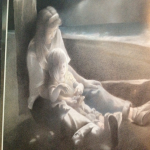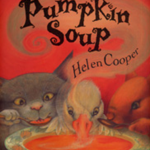
June 5, 2017, by Rupert Knight
The power of picture books in the primary classroom
In a previous blog Gill Johnson considered what we mean by quality children’s literature and why it might be valuable in the classroom in promoting successful reading and writing. In this blog, she explores the importance of picture books and thinks it is time to rediscover their power with all children.
If you have watched a young child at home or a child in the Early Years’ setting looking at a picture book, you will perhaps have noticed how intently the pictures are studied. A quality of ‘looking’ that we, as adults, often neglect as we move from the great divide between picture books and ‘chapter’ books. It’s rather like crossing the Rubicon – there appears to be no point of return.
What if we introduce and maintain a love of picture books in our schools across all phases – from Early Years right through to Key Stage 2? Would it help to foster a love for reading? I think it would.
Why picture books?
There are many reasons why using picture books is likely to foster a love of reading – here are five:
- Pure enjoyment.
Engaging with visual images is enjoyable and stimulating. The widely used English idiom that ‘one picture is worth a thousand words’ reflects our love of pictures. Children appreciate images and gain meaning from them.
- Engagement
Enjoyment leads to engagement. This is the same for us all – adults and children alike. A good picture books will absorb children’s attention and foster a positive association with books.
- Opportunities to talk
A stimulating image promotes talk and allows children to reflect on images – whether they are familiar, unusual or playful – if they have captured interest – children will want to talk about them. In talking they are building vocabulary and making meaning.
- Developing skills in reading and writing
Engaging with a picture book offers opportunities to develop English skills in an ‘holistic’ way. Engaging with pictures develops ‘visual literacy’, a skill that is undervalued in the current curriculum but as Fox (1994:159) reminds us: ‘The mental activities of a reader absorbed in a picture book have much in common with the processes which mature, highly competent readers employ as they read other kinds of texts, such as novels and poems.’
The opportunities to talk, can be structured and planned to allow children to ask questions, share with a partner or develop a dramatic moment ( a freeze frame or a small scene from the book, for example).
Pictures will often support children’s understanding of text and will enable children to develop their language comprehension skills.
Engagement in a picture book may stimulate a child to write – creating a character description from an image, for example, or creating their own picture book on a similar theme for younger children.
Opportunities for cross-curricular work are self-evident especially if using a range of fiction and non-fiction texts with striking illustrations. This involves careful planning, but the connections created for the children are likely to be memorable.
Finally, using themes that emerge from a picture book create opportunities for developing personal, social and emotional skills. The narrative and/or the images may also provide opportunities for discussions of a moral or spiritual nature. For more information on this visit the empathy lab site.
- Motivating reluctant readers
Children who are struggling with their reading for whatever reason (dyslexia, less experience, a special need), benefit from spending more time with picture books to develop their visual literacy thus avoiding books that are text heavy. Creating a culture where picture books are enjoyed and appreciated across upper and lower KS2 will benefit all children, but especially those who are not ready to independently read ‘chapter’ books.
Read a head teacher’s perspective on this too.
What do we mean by a quality picture book?
In a previous blog, I explored some elements of what might constitute quality children’s literature. Such elements are equally relevant to picture books. An alternative set of criteria might be those used to judge national competitions. In the UK, for example, the Kate Greenaway competition is nationally recognised.
The competition was established in 1955 and is named after the popular nineteenth century artist known for her fine children’s illustrations and designs. Her first book, Under the Window (1879), a collection of simple, idyllic verses about children, was a bestseller. So one starting point for thinking about quality in children’s picture books might be the criteria by which the nominations are judged for the Kate Greenaway competition. Let’s consider them:
The artistic style
Is the medium appropriate?
Is the artist’s personal style creative and distinctive?
Does the style work with the subject?
Is there a consistent quality of illustration throughout the book?
The Big, Big Sea by Martin Waddell and Jennifer Eachus (illustrator) is one example.

The sepia tones in the pictures convey the ethereal quality of a spontaneous walk to the beach under moonlight. The narrative represents a mother and child inhabiting a moment together and celebrates the ordinary becoming extraordinary through a shared bond. There is minimal text and it straddles the boundary between poetry and prose. As Doonan (1993:58) states:
Even if words and the pictures support each other without apparent contradiction, the pictures will convey an emotional mood; they will show something which the brief, declarative text does not say. They will exemplify feelings and states of being.
The format
Is the typography (i.e. format, typeface, print size, spacing, novelty features etc.) integral or intrusive?
Does the layout draw the reader in, or is it distracting?
How appropriate is the size and shape of the book?
What use is made of covers, end-papers and the title page?
Take Pumpkin Soup by Helen Cooper as an example.

The text is used playfully alongside the illustrations and includes small vignettes as well as larger illustrations. Every space is carefully considered.
Synergy of illustration and text
Are there recurring visual themes or images that enhance the reader’s understanding of the book?
How well do the illustrations and text relate to each other in terms of layout?
Are the images and text consistent with each other?
Do the illustrations enhance the text or are they ‘pictorial upholstery’, i.e. for decorative purposes only?
In the case of information books, how accurate and clear are the illustrations?

In The Red Tree by Shaun Tan there is a recurring image which children will pick up on. Have a look at this film.
The visual experience
How well does the book either offer the reader new experiences, or reflect their pre-existing experiences?
Does the book succeed in working at different levels for different readers?
What are the aesthetic qualities of the book?
What is the overall impact of the book on the reader?
In Sassy Gracie by James Sage and Pierre Pratt (illustrator) the illustrations are quirky, bold, colourful and therefore – visually ‘satisfying’. The strong, primary colours reflect the strength and boldness of Sassy Gracie herself. There is no moral in this story which children love! A talking point in itself.

Children’s Book Awards
If this blog has reawakened your interest in using picture books in the classroom – then have a look at the following links to book awards to keep up to date and for additional links relating to Children’s Literature refer back to my previous blog:
- Blue Peter
- CILIP Kate Greenaway Medal (The Medal is the only prize in the UK to solely reward outstanding illustration in a children’s book.)
- English 4-11 Book awards
- Guardian Children’s Fiction Prize
- The Children’s Book Award
- Waterstone’s Children’s Book Prize
Please share your thoughts in response to this blog or share your experiences of using picture books in the classroom.
References
Doonan, J. (1993) Looking at Picture Books. Stroud: Thimble Press
Fox, G. (1996) Reading Picture Books…How to? In, Styles, M., Bearne, E. and Watson, V. (eds.)
Voices Off: Texts, Contexts and Readers. London: Cassell

The use of picture books is also very powerful in teen years to portray dificult subjects and give background knowledge with empathy. Books such as Rose Blanche by Innocenti, The Storm in the Barn by Matt Phelan, Most Loved in all the World, by Tonya Hegamin. Pictures books also allow students with limited language skills, or those new to speaking the language, access to rich “reading” material.
Picture Books have become an integral part of the teaching of reading in my Year 6 class and not only do the children love it, they have made some fantastic progress this year.
Last week I shared the front cover of The Day the Crayons Quit and my class were desperate to read the entire book. We have now done a couple of comprehensions after reading and will also be completing a writing unit. 🙂